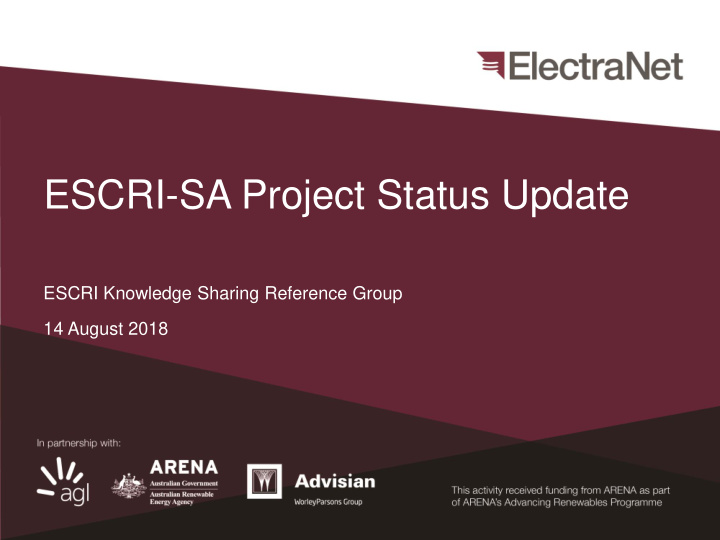



ESCRI-SA Project Status Update ESCRI Knowledge Sharing Reference Group 14 August 2018
Presentation outline > Scope & Location (Review) > Project Timing and Budget > SAPN Interface > Island Detection Scheme 2
SCOPE > Project Goals – Integrating intermittent renewable energy in an interconnected power system by coordinating the Battery Energy Storage System operation with the Wattle Point Wind Farm operation – Provision of a range of regulated and competitive market services e.g.: • Unserved Energy Reduction; • Fast Frequency Response; • FCAS; and • Cap Trading – Support of the Dalrymple load under islanded conditions – Wattle Point Wind Farm integration in an islanded system (aspirational goal) – Dissemination of knowledge as part of a Knowledge Sharing Program 3
LOCATION 4
Dalrymple North – Completed Site 5
Project Timing and Budget > AEMO registration received on 05.06.2018; > Registration supported by studies in PSS/E (for GPS / CPS) and PSCAD (for electro-magnetic transients assessment – e.g. at the transition between grid-connected to islanded status) > To be noted that no import was allowed (at any level and irrespective of network security impact) until the entire registration process was completed > Authorisation to import affected the ability to charge batteries and perform offline tests 6
Project Timing and Budget > Some project requirements and its R&D nature impose challenges in terms of optimising behaviour under various operating conditions, e.g.: – On-grid vs off-grid; – Speed of response (to network events and special protection schemes) vs stability > Such challenges attracted further work in optimising / fine-tuning the BESS behaviour, with associated time impacts > Ability to secure network outages attracted their own challenges, restrictions and delays > Mandatory coordination with SAPN and independent due-diligence review by SAPN (for BESS impact on their assets, on or off-grid) were also timely 7
Project Timing and Budget cont. Costs incurred in relation to SCADA works – uncharted territory and > requirements for various stakeholders – e.g. ElectraNet, AGL, AEMO control centres > Expenditure in relation to various studies: PSSE (GPS / CPS), PSCAD (EMTP), PowerFactory (protection performance assessment) > Complex commissioning process: – BESS parameters determined and behaviour simulated as much as possible via studies – Outages and coordination with multiple stakeholders (Enet, SAPN, AGL, AEMO, consultants, etc) – Real-life behaviour attracted re-tuning and a repeat of the above cycle 8
SAPN Interface > SAPN has a regulatory role and involvement in the project Mandatory due- diligence assessment of BESS impact on SAPN’s assets and > customers > SAPN protection changes to allow operation under islanded condition > Other SAPN works related to interfacing signals for local island black start > Changes required for metering / increased power / energy import and export > Minimum notification periods for outages affecting SAPN assets or for outages affecting SAPN customers 9
Island Detection Scheme (IDS) > SAPN requirements: – no local customers to be worse-off / no degradation of SAPN services reliability – as a result of BESS connection – Implementation of BESS anti-islanding capability > BESS anti-islanding activation for: – Insufficient number of batteries / inverters online (insufficient fault current contribution under islanded condition) – Islanding detection system in-operational 10
Island Detection Scheme cont. > Topology-based islanding system Bungama – Monitoring circuit breakers / disconnectors statuses at various substations (via auxiliary contacts) planned outages – Monitoring protection relays - i.e. CB imminent tripping under fault conditions detected via protection relays (even before the CBs would open) and transmitting trip signals via telecommunication systems unplanned outages > Topology based system extending to 5 substations (Dalrymple, Ardrossan West, Hummocks, Bungama and Waterloo) 11
Island Detection Scheme cont. > Respective substations all brownfield, with associated challenges in terms of documentation and accessibility for works Upon detection of island – IDS performs several functions > – Signal sent to BESS – for synchronous to isochronous transition – Signal sent to WPWF – offloading of excess generation – avoid overload of local ENet transformer from Dalrymple – Switches off relevant CBs at Dalrymple such that inadvertent reconnection to unsynchronised grid is prevented – Changes Dalrymple AVR behaviour / control in islanded condition; – Modifies limits for local special protection scheme – Performs controlled BESS re-synchronisation to the grid once adequate conditions occur 12
Cooling Modifications > Good battery room performance > Hot spots observed (with thermal camera) within certain areas in inverter room > Temperatures reached above 40°C (at which performance derating starts) during hold point testing which is more onerous than normal operation but with favourable ambient conditions (~10°C) > Additional AC modules to be installed, temperature settings to be reviewed > Ducting solution to better direct airflow to be installed 13
Questions
Thank you Dorin Costan ElectraNet 52-55 East Terrace Adelaide SA 5000 Ph. 0421 067 791 Email: Costan.Dorin@electraNet.com.au
Recommend
More recommend